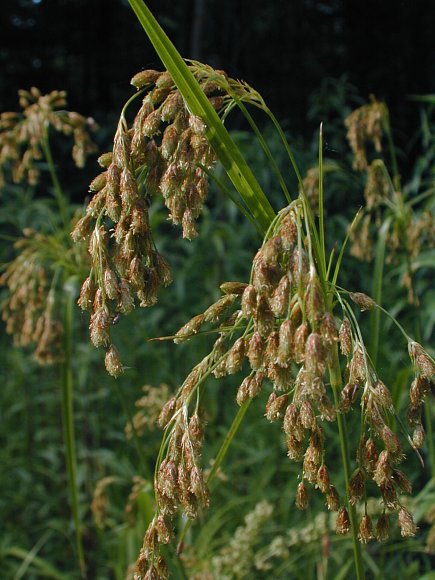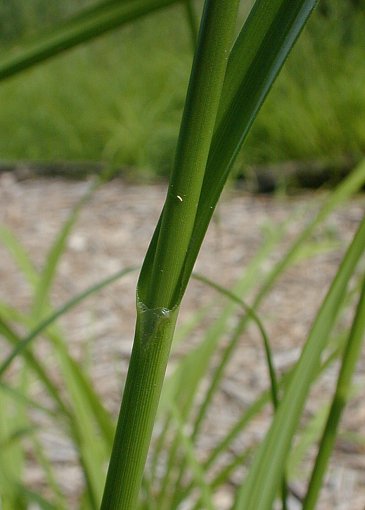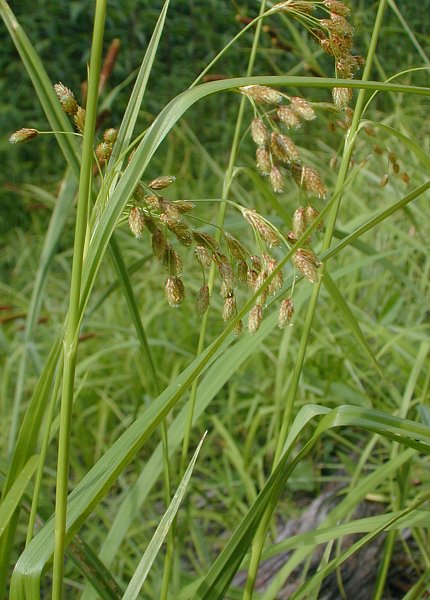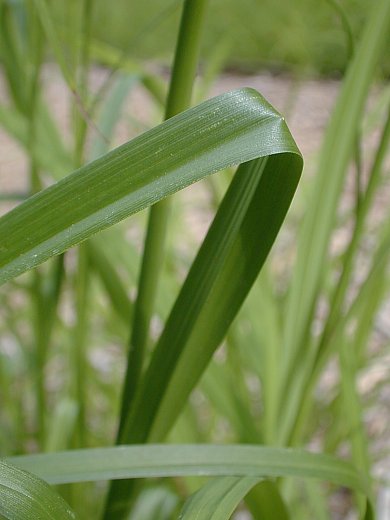Description: This perennial plant is 2–3½' tall, producing solitary culms or tufts of culms from its base. The culms are medium green, glabrous, terete, and unbranched; each culm has 5-8 alternate leaves along its length that are ascending, arching, or floppy. The leave blades are up to 14" long and 10 mm. across; they are some shade of green (medium, dark, or yellowish), glabrous, flattened, and often shallowly furrowed along their midribs. The leaf sheaths are light green to dark green, glabrous, longitudinally veined, and closed. The sheaths have small openings near their apices and they are thick-membranous immediately below these openings. The culm terminates in in an inflorescence that resembles a compound umbel of spikelets, except the floral branches (rays) do not originate at exactly the same location (and similarly for the pedicels of the spikelets). This inflorescence spans about 2½–5" across. The branches and pedicels of this inflorescence are slender, green, and hairless; they are also strongly nodding or drooping. At the base of the inflorescence, there are about 3 leafy bracts that are variable in length; one of these bracts usually extends beyond the inflorescence, while the remaining bracts are usually shorter than the inflorescence. There are also small membranous bracts at the base of each pseudo-umbellet of spikelets.

The central spikelet of each pseudo-umbellet is nearly sessile, while the remaining spikelets have pedicels that are 1-3 times their length. The spikelets are about 5-9 mm. long and about one-third as wide; they are oblongoid-ellipsoid to oblongoid-lanceoloid in shape. During the blooming period, the spikelets are light greenish brown in appearance, but they later become reddish brown to brown and somewhat bristly in appearance because of the dried-out styles of the florets. Each spikelet consists of a dense head of florets and their outer scales; these scales are arranged together in several overlapping series. Individual scales are about 2 mm. in length, lanceolate to ovate in shape, and hairless; they have broad central veins that are green. Each floret has 3 stamens, a tripartite style, and an ovary. The blooming period occurs during the summer, lasting 1-2 weeks. Cross-pollination of the florets is by wind. Afterwards, the florets are replaced by achenes (one achene per floret). These achenes are about 1 mm. long, bluntly 3-angled, and ovoid to obovoid in shape, tapering into short beaks at their apices. Each achene is surrounded by 5-6 fine bristles that are about 2 mm. in length. The achenes are small enough to be blown about by the wind and they probably float on water. The root system is fibrous and rhizomatous. Small colonies of plants are occasionally formed.

Cultivation:
The preference is full sun to light shade, wet to mesic conditions, and
soil with organic matter to retain moisture. However, it tolerates
rocky ground if there is sufficient moisture. In sunny areas that are
too dry, the leaf blades often become yellowish green and they may
wither away.
Range & Habitat:
The native Nodding Bulrush is common in most areas of Illinois; in the
NW section of the state, it is occasional (see Distribution
Map).
Habitats include openings in moist woodlands, powerline clearances in
wooded areas, moist meadows in wooded areas, sedge meadows,
river-bottom prairies, wet dolomite prairies, marshes and seeps, low
areas along rivers and ponds, moist depressions in limestone glades,
roadside ditches, and abandoned fields. Sometimes, this species is
found in mesic prairies, but this is less typical. Nodding Bulrush
can be found in both disturbed and higher quality natural areas.

Faunal
Associations:
Insects that feed on bulrushes (Scirpus
spp.) include semi-aquatic leaf beetles (Donacia spp., Plateumaris spp.),
the seed bug Cymus
angustatus, the plant bug Teratocoris discolor,
the aphids Rhopalosiphum
cerasifoliae and Schizaphis
scirpicola, larvae of the leaf-miner moth Elachista madarella,
stem-boring larvae of the moths Archanara
oblonga (Oblong Sedge Borer) and Archanara subflava
(Subflava Sedge Borer), larvae of the moth Leucania scirpicola
(Scirpus Wainscot), and larvae of Meropleon
diversicolor
(Multicolored Sedge Miner Moth); see Clark et al. (2004), Hoffman
(1996), Knight (1941), Blackman & Eastop (2013), Microleps
website
(2010), Covell (1986/2005), Harms & Grodowitz (2009). The
seeds and/or seedheads of bulrushes are an important source of food to
ducks, rails, and other wetland birds (see Bird Table
for a listing of these species). The foliage is eaten by the Canada
Goose and Trumpeter Swan, while the culms and rootstocks are eaten
occasionally by muskrats. Meadow Voles gnaw on the seedheads.
Photographic Location:
A powerline clearance at Busey Woods in Urbana, Illinois.

Comments: Nodding Bulrush (Scirpus pendulus) has attractive foliage and a rather elegant drooping inflorescence. To a greater extent than many other bulrushes (Scirpus spp.), this adaptable species often occurs in woodlands and other surprisingly dry areas, although it also occurs in wetlands. Nodding Bulrush can be distinguished from many other bulrushes by its flat leaf blades and drooping inflorescence. Nodding Bulrush has pedicels that are at least as long as the spikelets, while Wool Grass (Scirpus cyperinus) and other bulrushes with a similar appearance usually have sessile clusters of spikelets. The spikelets of Nodding Bulrush are oblongoid-ellipsoid to oblongoid-lanceoloid in shape and about 3 times as long as they are across, while the spikelets of other bulrushes are usually more ovoid in shape and about 2 times as long as they are across. Another important distinction is the appearance of the floral scales during the period of bloom: the scales of Nodding Bulrush have conspicuous central veins that are green, while the scales of other bulrushes usually have inconspicuous central veins.